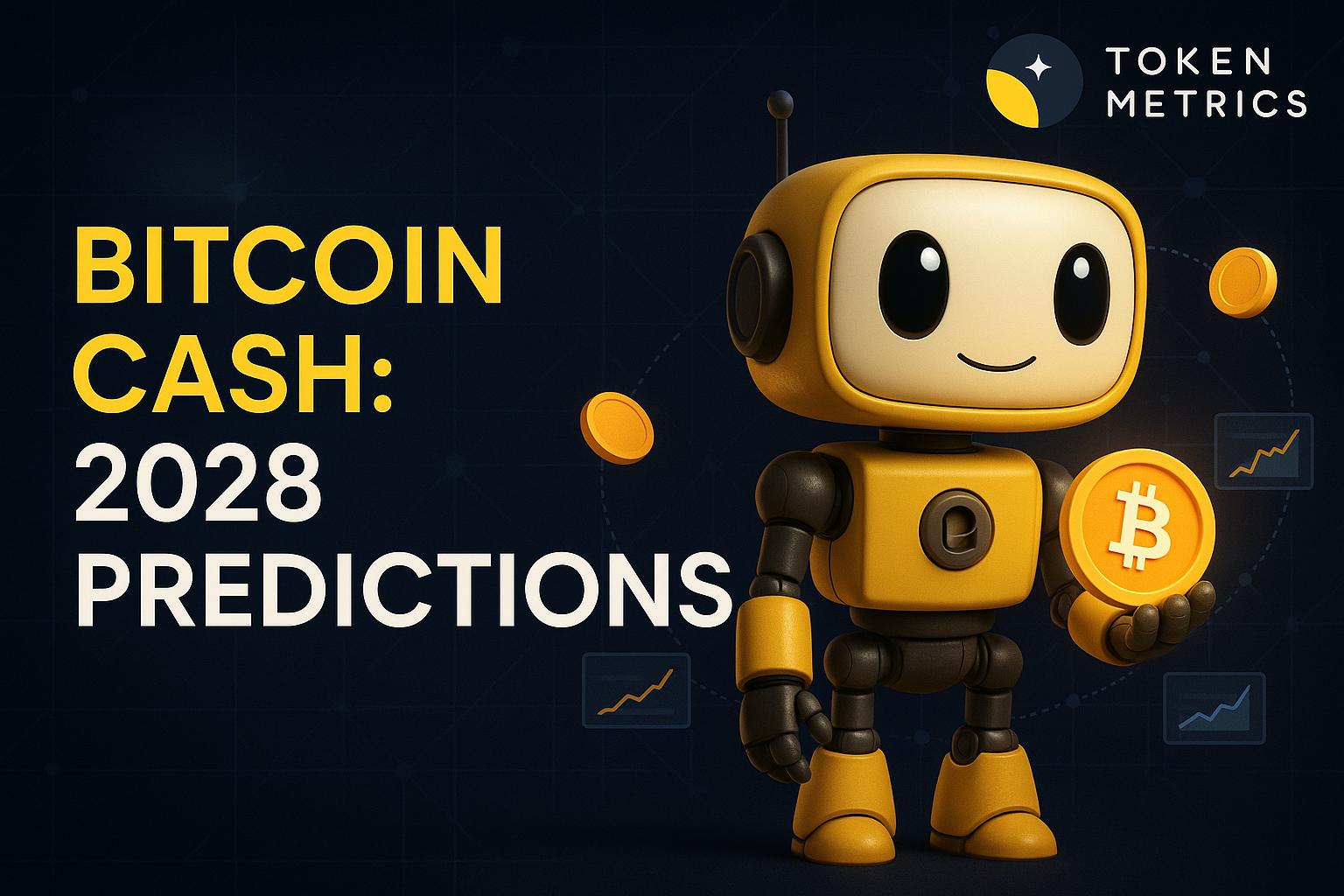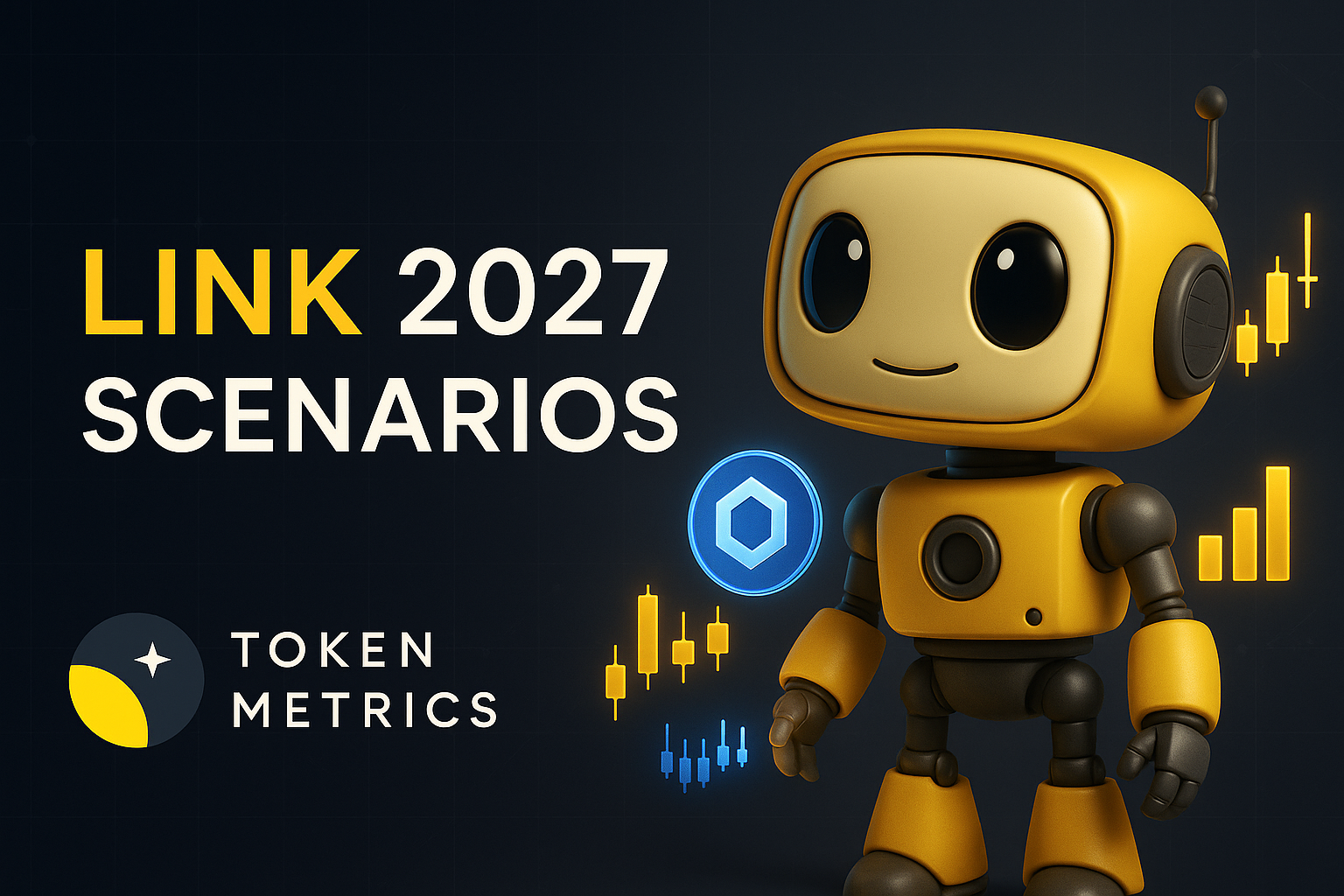Top Crypto Trading Platforms in 2025







%201.svg)
%201.svg)
Big news: We’re cranking up the heat on AI-driven crypto analytics with the launch of the Token Metrics API and our official SDK (Software Development Kit). This isn’t just an upgrade – it's a quantum leap, giving traders, hedge funds, developers, and institutions direct access to cutting-edge market intelligence, trading signals, and predictive analytics.
Crypto markets move fast, and having real-time, AI-powered insights can be the difference between catching the next big trend or getting left behind. Until now, traders and quants have been wrestling with scattered data, delayed reporting, and a lack of truly predictive analytics. Not anymore.
The Token Metrics API delivers 32+ high-performance endpoints packed with powerful AI-driven insights right into your lap, including:
Getting started with the Token Metrics API is simple:
At Token Metrics, we believe data should be decentralized, predictive, and actionable.
The Token Metrics API & SDK bring next-gen AI-powered crypto intelligence to anyone looking to trade smarter, build better, and stay ahead of the curve. With our official SDK, developers can plug these insights into their own trading bots, dashboards, and research tools – no need to reinvent the wheel.
%201.svg)
%201.svg)
Infrastructure protocols become more valuable as the crypto ecosystem scales and relies on robust middleware. Chainlink provides critical oracle infrastructure where proven utility and deep integrations drive long-term value over retail speculation. Increasing institutional adoption raises demand for professional-grade data delivery and security.
Token Metrics projections for LINK below span multiple total market cap scenarios from conservative to aggressive. Each tier assumes different levels of infrastructure demand as crypto evolves from speculative markets to institutional-grade systems. These bands frame LINK's potential outcomes into 2027.

Disclosure
Educational purposes only, not financial advice. Crypto is volatile, do your own research and manage risk.
How to read it: Each band blends cycle analogues and market-cap share math with TA guardrails. Base assumes steady adoption and neutral or positive macro. Moon layers in a liquidity boom. Bear assumes muted flows and tighter liquidity.
TM Agent baseline: Token Metrics lead metric for Chainlink, cashtag $LINK, is a TM Grade of 23.31%, which translates to a Sell, and the trading signal is bearish, indicating short-term downward momentum. This means Token Metrics currently does not endorse $LINK as a long-term buy at current conditions.
Live details: Chainlink Token Details
Affiliate Disclosure: We may earn a commission from qualifying purchases made via this link, at no extra cost to you.
Token Metrics scenarios span four market cap tiers, each representing different levels of crypto market maturity and liquidity:
8T: At an 8 trillion dollar total crypto market cap, LINK projects to $26.10 in bear conditions, $30.65 in the base case, and $35.20 in bullish scenarios.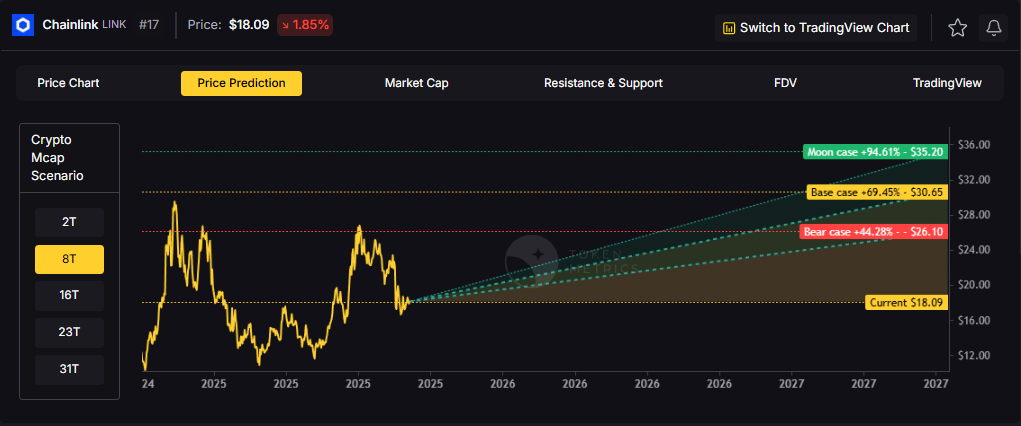
16T: Doubling the market to 16 trillion expands the range to $42.64 (bear), $56.29 (base), and $69.95 (moon).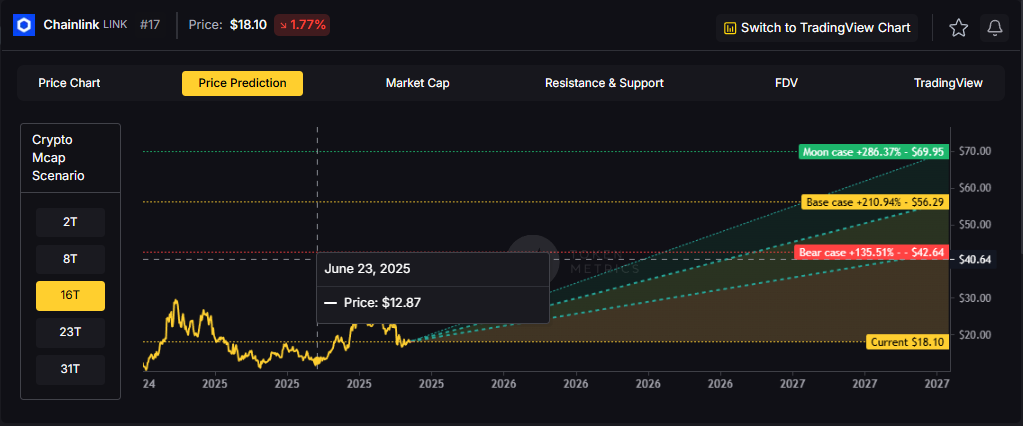
23T: At 23 trillion, the scenarios show $59.18, $81.94, and $104.70 respectively.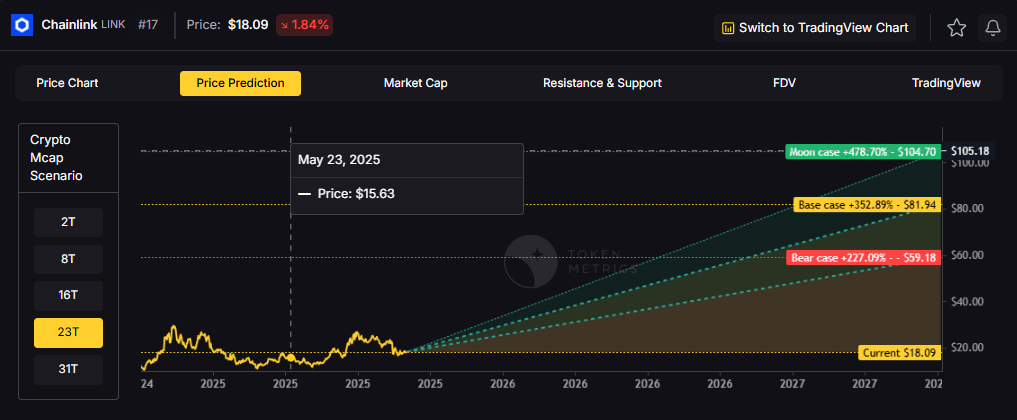
31T: In the maximum liquidity scenario of 31 trillion, LINK could reach $75.71 (bear), $107.58 (base), or $139.44 (moon).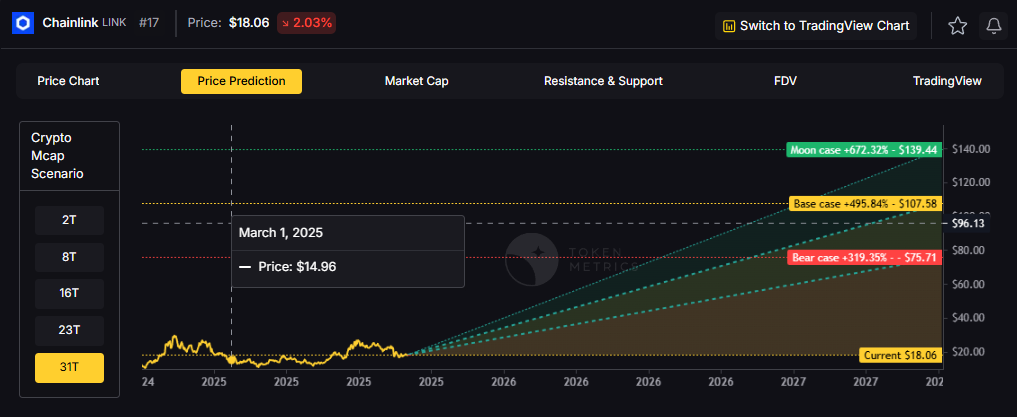
Chainlink represents one opportunity among hundreds in crypto markets. Token Metrics Indices bundle LINK with top one hundred assets for systematic exposure to the strongest projects. Single tokens face idiosyncratic risks that diversified baskets mitigate.
Historical index performance demonstrates the value of systematic diversification versus concentrated positions.
Chainlink is a decentralized oracle network that connects smart contracts to real-world data and systems. It enables secure retrieval and verification of off-chain information, supports computation, and integrates across multiple blockchains. As adoption grows, Chainlink serves as critical infrastructure for reliable data feeds and automation.
The LINK token is used to pay node operators and secure the network’s services. Common use cases include DeFi price feeds, insurance, and enterprise integrations, with CCIP extending cross-chain messaging and token transfers.
Vision: Chainlink aims to create a decentralized, secure, and reliable network for connecting smart contracts with real-world data and systems. Its vision is to become the standard for how blockchains interact with external environments, enabling trust-minimized automation across industries.
Problem: Smart contracts cannot natively access data outside their blockchain, limiting their functionality. Relying on centralized oracles introduces single points of failure and undermines the security and decentralization of blockchain applications. This creates a critical need for a trustless, tamper-proof way to bring real-world information onto blockchains.
Solution: Chainlink solves this by operating a decentralized network of node operators that fetch, aggregate, and deliver data from off-chain sources to smart contracts. It uses cryptographic proofs, reputation systems, and economic incentives to ensure data integrity. The network supports various data types and computation tasks, allowing developers to build complex, data-driven decentralized applications.
Market Analysis: Chainlink is a market leader in the oracle space and a key infrastructure component in the broader blockchain ecosystem, particularly within Ethereum and other smart contract platforms. It faces competition from emerging oracle networks like Band Protocol and API3, but maintains a strong first-mover advantage and widespread integration across DeFi, NFTs, and enterprise blockchain solutions. Adoption is driven by developer activity, partnerships with major blockchain projects, and demand for secure data feeds. Key risks include technological shifts, regulatory scrutiny on data providers, and execution challenges in scaling decentralized oracle networks. As smart contract usage grows, so does the potential for oracle services, positioning Chainlink at the center of a critical niche, though its success depends on maintaining security and decentralization over time.
Fundamental Grade: 74.58% (Community 81%, Tokenomics 100%, Exchange 100%, VC —, DeFi Scanner 17%).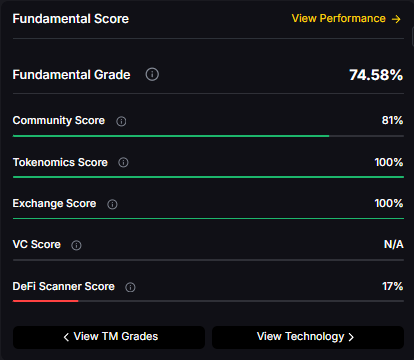
Technology Grade: 88.50% (Activity 81%, Repository 72%, Collaboration 100%, Security 86%, DeFi Scanner 17%).
Can LINK reach $100?
Yes. Based on the scenarios, LINK could reach $100+ in the 23T moon case. The 23T tier projects $104.70 in the moon case. Not financial advice.
What price could LINK reach in the moon case?
Moon case projections range from $35.20 at 8T to $139.44 at 31T. These scenarios assume maximum liquidity expansion and strong Chainlink adoption. Not financial advice.
Should I buy LINK now or wait?
Timing depends on risk tolerance and macro outlook. Current price of $18.09 sits below the 8T bear case in the scenarios. Dollar-cost averaging may reduce timing risk. Not financial advice.
Track live grades and signals: Token Details
Want exposure? Buy LINK on MEXC
Disclosure
Educational purposes only, not financial advice. Crypto is volatile, do your own research and manage risk.
Discover the full potential of your crypto research and portfolio management with Token Metrics. Our ratings combine AI-driven analytics, on-chain data, and decades of investing expertise—giving you the edge to navigate fast-changing markets. Try our platform to access scenario-based price targets, token grades, indices, and more for institutional and individual investors. Token Metrics is your research partner through every crypto market cycle.
%201.svg)
%201.svg)
The crypto market is tilting bullish into 2026 as liquidity, infrastructure, and participation improve across the board. Clearer rules and standards are reshaping the classic four-year cycle, flows can arrive earlier, and strength can persist longer than in prior expansions.
Institutional access is widening through ETFs and custody, while L2 scaling and real-world integrations help sustain on‑chain activity. This healthier backdrop frames our scenario work for HYPE. The ranges below reflect different total crypto market sizes and the share Hyperliquid could capture under each regime.
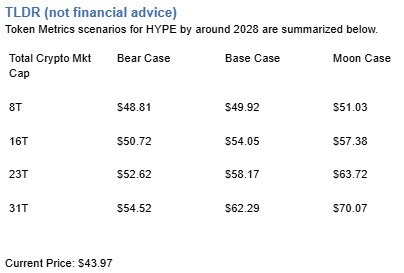
Disclosure
Educational purposes only, not financial advice. Crypto is volatile, do your own research and manage risk.
How to read it: Each band blends cycle analogues and market-cap share math with TA guardrails. Base assumes steady adoption and neutral or positive macro. Moon layers in a liquidity boom. Bear assumes muted flows and tighter liquidity.
TM Agent baseline: Token Metrics TM Grade is 73.9%, a Buy, and the trading signal is bearish, indicating short-term downward momentum. This means Token Metrics judges HYPE as fundamentally attractive over the long term, while near-term momentum is negative and may limit rallies.
Live details: Hyperliquid Token Details
Affiliate Disclosure: We may earn a commission from qualifying purchases made via this link, at no extra cost to you.
Scenario Analysis
Token Metrics scenarios span four market cap tiers, each representing different levels of crypto market maturity and liquidity:
8T: At an 8 trillion dollar total crypto market cap, HYPE projects to $48.81 in bear conditions, $49.92 in the base case, and $51.03 in bullish scenarios.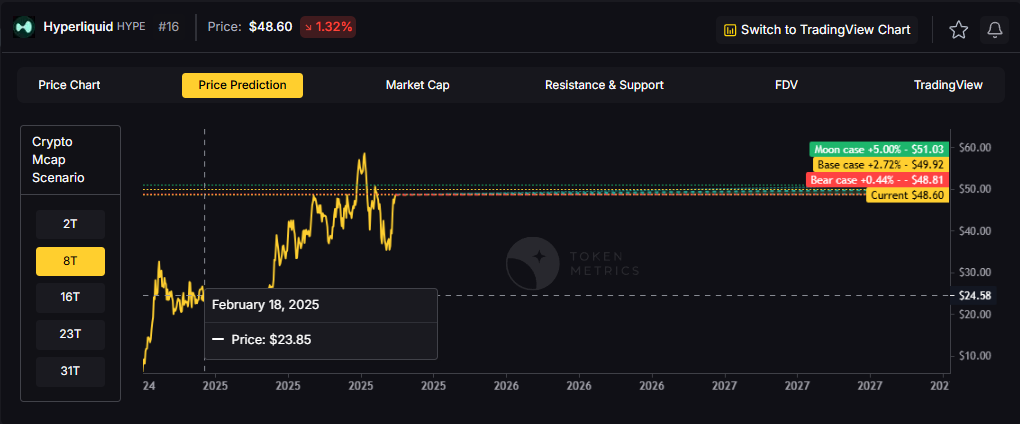
16T: Doubling the market to 16 trillion expands the range to $50.72 (bear), $54.05 (base), and $57.38 (moon).
23T: At 23 trillion, the scenarios show $52.62, $58.17, and $63.72 respectively.
31T: In the maximum liquidity scenario of 31 trillion, HYPE could reach $54.52 (bear), $62.29 (base), or $70.07 (moon).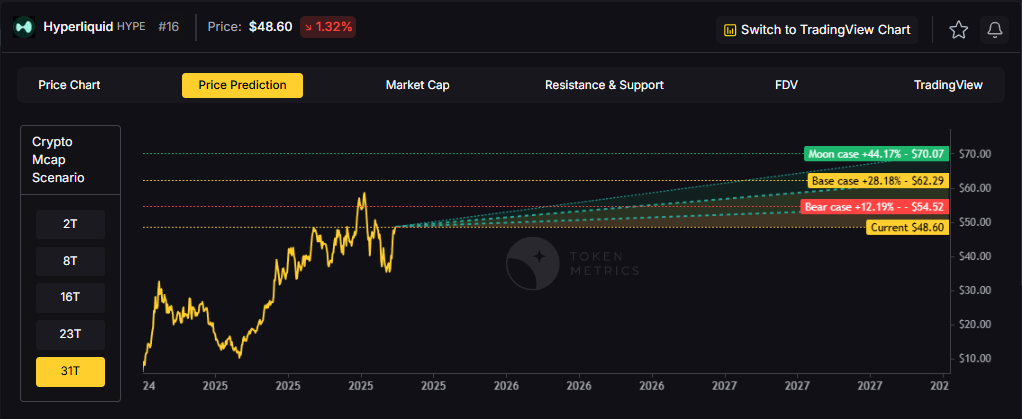
Each tier assumes progressively stronger market conditions, with the base case reflecting steady growth and the moon case requiring sustained bull market dynamics.
Diversification matters. HYPE is compelling, yet concentrated bets can be volatile. Token Metrics Indices hold HYPE alongside the top one hundred tokens for broad exposure to leaders and emerging winners.
Our backtests indicate that owning the full market with diversified indices has historically outperformed both the total market and Bitcoin in many regimes due to diversification and rotation.
Hyperliquid is a decentralized exchange focused on perpetual futures with a high-performance order book architecture. The project emphasizes low-latency trading, risk controls, and capital efficiency aimed at professional and retail derivatives traders. Its token, HYPE, is used for ecosystem incentives and governance-related utilities.
Can HYPE reach $60?
Yes, the 23T and 31T tiers imply ranges above $60 in the Base and Moon bands, though outcomes depend on liquidity and adoption. Not financial advice.
Is HYPE a good long-term investment?
Outcome depends on adoption, liquidity regime, competition, and supply dynamics. Diversify and size positions responsibly.
Disclosure
Educational purposes only, not financial advice. Crypto is volatile, do your own research and manage risk.
Token Metrics delivers AI-based crypto ratings, scenario projections, and portfolio tools so you can make smarter decisions. Discover real-time analytics on Token Metrics.
%201.svg)
%201.svg)
The Layer 1 competitive landscape is consolidating as markets recognize that specialization matters more than being a generic "Ethereum killer." Cardano positions itself in this multi-chain world with specific technical and ecosystem advantages. Infrastructure maturity around custody, bridges, and developer tools makes alternative L1s more accessible heading into 2026.
The scenario projections below map different market share outcomes for ADA across varying total crypto market sizes. Base cases assume Cardano maintains current ecosystem momentum, while moon scenarios factor in accelerated adoption and bear cases reflect increased competitive pressure.

Disclosure
Educational purposes only, not financial advice. Crypto is volatile, do your own research and manage risk.
How to read it: Each band blends cycle analogues and market-cap share math with TA guardrails. Base assumes steady adoption and neutral or positive macro. Moon layers in a liquidity boom. Bear assumes muted flows and tighter liquidity.
TM Agent baseline: Token Metrics lead metric for Cardano, cashtag $ADA, is a TM Grade of 29.72%, which translates to a Sell, and the trading signal is bearish, indicating short-term downward momentum. This combination means Token Metrics does not currently endorse $ADA as a long-term buy at current levels. A brief market context: Bitcoin's direction remains the dominant macro driver for smart contract platforms, so sustained upside for $ADA would require a broader crypto risk-on regime and improving fundamentals or developer activity for Cardano.
Live details: Cardano Token Details
Affiliate Disclosure: We may earn a commission from qualifying purchases made via this link, at no extra cost to you.
Token Metrics scenarios span four market cap tiers, each representing different levels of crypto market maturity and liquidity:




Each tier assumes progressively stronger market conditions, with the base case reflecting steady growth and the moon case requiring sustained bull market dynamics.
Cardano represents one opportunity among hundreds in crypto markets. Token Metrics Indices bundle ADA with top one hundred assets for systematic exposure to the strongest projects. Single tokens face idiosyncratic risks that diversified baskets mitigate.
Historical index performance demonstrates the value of systematic diversification versus concentrated positions.
Cardano is a blockchain platform designed to support secure, scalable, and sustainable decentralized applications and smart contracts. It is known for its research-driven development approach, emphasizing peer-reviewed academic research and formal verification methods to ensure reliability and security. As a proof-of-stake Layer 1 blockchain, Cardano aims to offer energy efficiency and long-term scalability, positioning itself as a competitor to platforms like Ethereum. Its native token, ADA, is used for transactions, staking, and governance. Adoption is driven by technological rigor and ecosystem growth, though progress has been criticized for being slow compared to more agile competitors. Risks include execution delays, competition, and market volatility.
Cardano’s vision is to create a decentralized platform that enables sustainable and inclusive economic systems through advanced cryptography and scientific methodology. It aims to bridge gaps between traditional financial systems and blockchain technology, promoting accessibility and security for users globally.
Token Metrics AI provides comprehensive context on Cardano's positioning and challenges.


Can ADA reach $4?
Based on the scenarios, ADA could reach $4 in the 31T moon case. The 31T tier projects $4.27 in the moon case. Not financial advice.
Can ADA 10x from current levels?
At current price of $0.65, a 10x would reach $6.50. This falls within none of the provided scenarios, which top out at $4.27 in the 31T moon case. Bear in mind that 10x returns require substantial market cap expansion. Not financial advice.
What price could ADA reach in the moon case?
Moon case projections range from $1.16 at 8T to $4.27 at 31T. These scenarios assume maximum liquidity expansion and strong Cardano adoption. Not financial advice.
Disclosure
Educational purposes only, not financial advice. Crypto is volatile, do your own research and manage risk.

%201.svg)
%201.svg)
In the fast-evolving landscape of digital finance, the year 2025 brings renewed interest in tools that facilitate efficient and accurate access to cryptocurrency data. APIs (Application Programming Interfaces) serve as the backbone connecting various applications to real-time and historical market, blockchain, and transactional data. This article explores the 10 best cryptocurrency APIs in 2025, emphasizing their features, data coverage, and potential uses within the cryptocurrency and blockchain ecosystem. Understanding the capabilities of these APIs can help developers, analysts, and businesses build insightful applications, conduct data-driven research, and enhance crypto trading strategies.
Cryptocurrency APIs provide structured data access ranging from coin prices, market capitalization, trading volumes, blockchain metrics, to wallet information. They offer endpoints that facilitate seamless integration with various systems such as crypto trading platforms, portfolio trackers, data analytics tools, and research applications. The choice of a crypto API depends on factors including data accuracy, latency, historical data availability, ease of use, pricing, and compatibility with AI-driven research tools. Notably, the Token Metrics API has emerged as a prominent solution providing extensive market data and analytics for developers.
In compiling the top 10 cryptocurrency APIs, several key criteria were considered:
While APIs supply raw and processed data, their integration with advanced analytical and AI tools is critical for comprehensive crypto trading and research strategies. Platforms such as the crypto trading platform Token Metrics use AI-powered models combined with API data streams to generate quantitative insights and ratings. These assist users in making informed research assessments by evaluating coin fundamentals, sentiment, and market trends without endorsing specific investments.
Developers and analysts utilizing cryptocurrency APIs should consider structuring API outputs into machine-readable formats optimized for data science workflows. Combining multiple sources, for example, market data from CoinGecko with on-chain metrics from Glassnode, can provide multidimensional perspectives facilitating robust scenario analysis and trend forecasting.
The landscape of cryptocurrency APIs in 2025 is rich and varied, catering to diverse needs from market data aggregation to in-depth blockchain analytics. Selecting the best crypto API involves balancing coverage, reliability, and compatibility with analytical frameworks. The Token Metrics API, among the leading options, exemplifies how comprehensive data and AI integration can support sophisticated crypto research workflows.
By leveraging these APIs and complementing them with AI-powered platforms such as Token Metrics, developers and analysts can navigate the complex digital asset market with enhanced clarity and data-driven understanding.
This article is for educational and informational purposes only and does not constitute financial advice. Cryptocurrency markets carry inherent risks, and users should conduct their own research and consider consulting professional advisors before making any financial decisions.

%201.svg)
%201.svg)
As the blockchain and crypto ecosystems continue to evolve rapidly, access to reliable and comprehensive cryptocurrency data through APIs remains vital for developers, analysts, and businesses. APIs facilitate the integration of real-time market data, historical analytics, and on-chain information into applications and services. With 2025 shaping up to further advance the crypto landscape, selecting the right crypto API can significantly impact the quality of data-driven insights and automation capabilities.
This article explores the 5 best cryptocurrency APIs in 2025, focusing on their features, data coverage, and analytical strengths to support developers and researchers in making informed technology choices. We also highlight the role of AI-driven tools like Token Metrics API in enhancing crypto data research.
Choosing the best crypto API requires evaluating several key factors beyond mere price feeds. Important criteria include:
The Token Metrics API stands as a leading choice for 2025. It combines traditional market data with AI-powered analytics, fundamental scores, and predictive signals. This fusion allows users to enrich their platforms with both raw data and research-grade insights.
Key Features:
Further, Token Metrics offers a complementary crypto trading platform that leverages this API, showcasing practical implementation in trading research.
CoinGecko remains one of the most popular free and paid crypto APIs, favored for its extensive token database and community-focused data. It excels at delivering real-time pricing, volume data, and detailed token metadata including developer activity and liquidity scores.
Key Features:
CryptoCompare has built a reputation for combined market data and social sentiment in a single API package. Its focus extends beyond spot prices to include derivatives and exchange-level metrics, making it useful for comprehensive market analysis.
Key Features:
Nomics delivers high-quality primary market data emphasizing transparency and accuracy. Their API offers aggregated pricing, supply data, and exchange volume metrics with premium tiers providing enhanced data granularity.
Key Features:
Glassnode is a leader in on-chain analytics, offering APIs that provide deep blockchain-level insights beyond market prices. Its datasets include wallet behavior, transaction flows, and network health indicators, making it ideal for fundamental blockchain research.
Key Features:
Utilizing crypto APIs efficiently involves defining clear objectives—whether for portfolio tracking, app development, or research. Developers and analysts should consider combining multiple data sources to obtain a multidimensional view of the markets.
Incorporating AI-based analytics, such as those offered through the Token Metrics API, can augment traditional price and volume data by providing predictive insights and risk assessments. This integration supports more nuanced research and decision-making processes.
It is also important to monitor API usage limits, latency, and data update frequencies to ensure smooth operation of dependent applications.
In the dynamic and data-intensive world of cryptocurrency, accessing robust and feature-rich APIs is fundamental to gaining insights and building competitive products. The top 5 cryptocurrency APIs for 2025 highlighted here present options catering to varied needs—from real-time market data to advanced AI-enabled analytics and on-chain metrics.
Among them, the Token Metrics API distinguishes itself by combing comprehensive crypto market data with AI-enhanced predictive research, making it a valuable resource for projects seeking to integrate both fundamental and technical perspectives.
Those engaged in crypto development and research may benefit from exploring these APIs in alignment with their specific analytical or operational requirements.
This content is for educational and informational purposes only. It does not constitute financial, investment, or legal advice. Users should conduct their own research and consult professionals before relying on any cryptocurrency data or platforms.

%201.svg)
%201.svg)
In today’s digital ecosystem, API platforms serve as critical infrastructure for enabling seamless communication between software applications. Whether facilitating data exchange, integration, or automation, API platforms empower developers and organizations to build scalable and modular systems adaptable to evolving technological needs.
This article explores the concept of API platforms with a focus on their relevance in various industries, including their increasing role in crypto trading environments where secure and reliable APIs support advanced analytics and automation.
An API platform is a suite of tools, services, and technologies designed to create, manage, and monitor Application Programming Interfaces (APIs). It offers developers a structured environment to develop APIs that enable software components to interact efficiently. Key features typically include:
For example, the Token Metrics API represents a contemporary crypto API platform offering comprehensive data endpoints to support quantitative analysis and integration within broader crypto trading platforms.
Organizations embracing API platforms can unlock several advantages:
These features are particularly crucial in crypto-related APIs where timeliness, accuracy, and security are paramount—for instance, when utilizing a crypto API to inform automated trading decisions within a crypto trading platform.
The cryptocurrency space has rapidly adopted API platforms to support data-driven trading and analytics. Crypto APIs provide access to market data, pricing feeds, on-chain information, and sentiment metrics. These APIs enable developers and analysts to embed real-time data effortlessly into their applications or trading bots.
For example, Token Metrics API delivers AI-driven crypto asset ratings and analytics that enhance decision support systems. Such integrations form the backbone of sophisticated crypto trading platforms, allowing users to research fundamentals and perform technical analysis with the aid of advanced algorithms.
Selecting the right API platform depends on specific organizational needs. Several factors to evaluate include:
Platforms like Token Metrics API exemplify these attributes, particularly in the crypto sector where precision and security are vital.
AI-driven platforms can augment API capabilities by providing predictive analytics, anomaly detection, and automated decision support. Combining APIs with AI tools enhances the value extracted from data streams. For instance, Token Metrics offers AI-powered insights accessible through their API platform, providing structured ratings and metrics that can be integrated into broader trading applications.
Such integrations facilitate rapid, data-backed evaluations without manual intervention, improving operational efficiency while supporting developers and analysts with actionable intelligence.
Successful integration of API platforms can be supported by adhering to the following principles:
For developers working in crypto markets, relying on a specialized crypto API platform that integrates seamlessly with AI research components such as those from Token Metrics can markedly enhance the robustness of their applications.
API platforms represent a foundational element in modern software development, enabling agility and interoperability across systems. Their significance is pronounced in data-intensive sectors such as cryptocurrency, where real-time, reliable data access supported by AI analytics can facilitate deeper research and more sophisticated applications.
By carefully evaluating documentation, security, scalability, and integration capabilities, organizations can select API platforms that align with their operational goals. Leveraging resources like the Token Metrics API and related crypto trading platforms supports a comprehensive approach to building next-generation tools in the crypto ecosystem.
This article is intended for educational purposes only. It does not constitute financial, investment, or trading advice. Readers should conduct their own research and consult with professional advisors before making decisions based on API data or analysis.

%201.svg)
%201.svg)
In the ever-evolving landscape of digital technology, data APIs have become fundamental tools that enable seamless data exchange between software systems. APIs, or Application Programming Interfaces, function as bridges that allow different applications to communicate and share data efficiently. Specifically, in the cryptocurrency domain, data APIs provide access to crucial market and blockchain data essential for analysis, development, and trading activities.
A data API is a set of protocols and tools that allows developers to access and manipulate structured data from an external service or database. Unlike general APIs, data APIs focus on delivering datasets that can be used for analytics, reporting, and decision-making. These interfaces often provide endpoints for querying real-time or historical data, enabling users to fetch information on demand.
In cryptocurrency markets, rapid access to accurate and reliable data is paramount. Data APIs serve as the backbone for developers, analysts, and traders to obtain:
Given the volatile and decentralized nature of crypto assets, data APIs enable participants to build data-driven models and tools, enhancing transparency and operational efficiency.
When selecting or utilizing a data API, it is important to consider several critical features:
Token Metrics API represents a sophisticated solution designed to provide comprehensive cryptocurrency market data and analytics through an accessible interface. It delivers AI-driven insights, fundamental metrics, and market data that empower developers and analysts to augment their research and applications.
The API supports multiple endpoints facilitating data retrieval including price history, on-chain analytics, sentiment metrics, and other fundamental indicators. This breadth and depth make it a valuable tool for anyone seeking structured and actionable crypto data.
Data APIs serve various practical purposes in the crypto ecosystem, including but not limited to:
The integration of artificial intelligence with data APIs introduces new possibilities for crypto research and analytics. AI models can analyze vast quantities of data accessed through APIs to generate insights such as predictive analytics, sentiment scoring, and risk evaluation.
For example, Token Metrics incorporates AI-driven analytics that complement raw data by producing research-based ratings and forecasts to help users interpret complex market dynamics efficiently.
Developers aiming to incorporate crypto data into their applications can utilize the Token Metrics API for a reliable source of market and analytic data. The API features RESTful endpoints with JSON responses, making it straightforward to integrate with modern development stacks.
Comprehensive documentation guides users through authentication, available endpoints, and example queries, allowing efficient adoption. Users can tailor data requests to fit varying needs, from simple price retrieval to complex on-chain metrics.
Data APIs are indispensable tools for accessing structured and real-time cryptocurrency data that power research, analytics, and trading platforms. Choosing a robust and reliable API, such as the Token Metrics API, enables more informed and data-driven operations in the fast-paced crypto space.
Combined with AI-driven analytical tools like those from Token Metrics, data APIs unlock deeper insights by converting raw data into actionable intelligence without any promotional bias or investment recommendations.
This article is for educational purposes only and does not constitute financial, investment, or trading advice. Users should conduct their own research and consult professionals before making any financial decisions.

%201.svg)
%201.svg)
In the rapidly evolving landscape of digital asset markets, crypto API trading has emerged as a foundational technology enabling users to connect trading algorithms, data feeds, and analytical tools directly to crypto exchanges. By leveraging APIs (Application Programming Interfaces), traders and developers gain programmatic access to market data and can execute trades efficiently, often enhancing decision-making processes.
This article explores the essentials of crypto API trading, including the role of APIs in trading ecosystems, the benefits and challenges of automated interactions with crypto exchanges, and how AI-driven analytics can complement such technology.
A crypto API is a set of protocols and tools that allows developers to connect software applications with cryptocurrency exchange platforms or data providers. These APIs facilitate fetching market data like price quotes, order books, trade history, and executing orders programmatically.
Among prominent offerings, Token Metrics API stands out by delivering not just raw data but also AI-powered insights and metrics that can support nuanced research and analysis. This elevates the capabilities of API users in developing robust algorithmic strategies or real-time market monitoring tools.
Understanding different categories of crypto APIs is crucial for selecting appropriate endpoints based on trading or analytical needs:
The Token Metrics API integrates several of these features, combining data with AI-driven rating systems that users can incorporate into their own trading tools.
Using APIs to automate aspects of crypto trading platforms offers several advantages:
Despite the benefits, crypto API trading entails certain challenges and factors to consider:
Artificial Intelligence (AI) plays an increasingly important role in augmenting crypto API trading by providing sophisticated analytical layers atop raw data streams:
The Token Metrics API exemplifies this application by integrating AI-driven ratings and metrics that users can incorporate programmatically to enhance automated trading or research workflows.
For individuals or teams interested in utilizing crypto API trading, a systematic approach is recommended:
Selection of a compatible and reliable crypto trading platform is vital for effective API trading integrations. The platform should offer comprehensive API support, detailed documentation, and robust security measures.
A notable example is Token Metrics, which provides an interface combining market data, AI-driven analytics, and accessible APIs designed to empower sophisticated research and trading automation.
Crypto API trading is an indispensable component of the modern cryptocurrency ecosystem, enabling automation, systematic analysis, and scalable interaction with complex markets. When combined with AI-powered tools such as those offered by Token Metrics, users can enhance their research capabilities and gain deeper insights from data.
As blockchain technology and market infrastructure continue to mature, APIs will play an increasingly integral role in facilitating innovation and efficiency in crypto trading practices.
This article is for educational purposes only and does not constitute investment advice, solicitation, or an offer to buy or sell any cryptocurrency or financial product. Readers should conduct their own research and consult professional advisors when making financial decisions.

%201.svg)
%201.svg)
In the evolving landscape of blockchain technology and cryptocurrency, web crypto APIs have become vital tools for developers, analysts, and businesses seeking to interact with decentralized networks and crypto market data. A web crypto API acts as an intermediary that enables applications to communicate with blockchain data, execute transactions, and retrieve real-time analytics seamlessly.
This guide explores core concepts behind web crypto APIs, common use cases, important technical considerations, and how AI-driven platforms, including Token Metrics API, contribute to comprehensive crypto data analysis for informed decision-making.
A web crypto API is an application programming interface designed specifically to facilitate interaction between a web application and cryptocurrency networks or market data sources. It abstracts complex blockchain operations into manageable function calls developers can use to access wallets, process transactions, fetch token information, and obtain live or historical price data.
Types of web crypto APIs include those serving:
With the rise of decentralized finance (DeFi), these APIs have expanded to include smart contract calls and decentralized exchange functionalities, enhancing their versatility.
When selecting or understanding a top crypto API, consider several critical features:
Leading solutions like the Token Metrics API exemplify these qualities, pairing market data access with AI-driven research capabilities.
Web crypto APIs have diverse applications across the crypto ecosystem. Notable use cases include:
Developers aiming to incorporate crypto APIs into web applications should consider the following technical aspects:
Choosing a provider like the Token Metrics API ensures access to well-structured endpoints and comprehensive documentation.
Beyond raw data access, integrating AI models alongside crypto APIs enriches analytical insights. Platforms such as Token Metrics leverage machine learning to generate token ratings based on deep fundamental and technical analysis, helping users prioritize research focuses objectively.
Benefits of AI integration include:
Combining a dependable crypto API with AI-powered platforms offers a robust toolkit for comprehensive crypto market research and development.
When selecting a web crypto API for your project or analysis, consider applying these best practices:
Leading providers such as Token Metrics API maintain transparent service specifications making evaluations easier.
Web crypto APIs represent foundational technology enabling seamless integration between web applications and the complex world of cryptocurrency markets and blockchains. By providing real-time and historical data, transaction capabilities, and increasingly incorporating AI-driven analytics from platforms like Token Metrics, these APIs empower developers and analysts to build innovative, data-informed solutions.
As crypto ecosystems expand, understanding and effectively leveraging web crypto APIs will continue to be essential for anyone involved in crypto technology development or market research.
This blog post is for educational purposes only and does not constitute financial, investment, or trading advice. Always conduct your own research and consult professionals before making decisions related to cryptocurrencies.

%201.svg)
%201.svg)
The landscape of cryptocurrency is rapidly evolving, creating a growing demand for reliable and comprehensive data sources. For developers, analysts, and enthusiasts, crypto APIs enable access to real-time and historical market data, on-chain metrics, and other critical information necessary for data-driven decision-making. In this article, we explore what constitutes the best crypto API, with an emphasis on evaluating functionality, reliability, and the integration of advanced analytics.
A crypto API provides programmatic access to cryptocurrency market data, facilitating automated retrieval and analysis without manual intervention. These APIs typically cover aspects such as coin prices, trading volumes, order books, blockchain statistics, and sentiment signals. The best crypto API solutions ensure accuracy, low latency, and broad coverage of assets across various exchanges.
One notable provider is the Token Metrics API, which offers extensive data feeds ranging from market prices to token fundamentals combined with AI-driven analytics. Such integration supports comprehensive asset evaluation beyond mere price metrics.
Depending on use case, crypto APIs can be categorized as follows:
Choosing the most suitable crypto API involves systematically assessing several dimensions tailored to your objectives:
One advancement in the crypto data landscape is the fusion of traditional market data with artificial intelligence. Providers like Token Metrics utilize machine learning algorithms to generate token ratings and market insights. Incorporating these layers of analysis into your data workflow can streamline fundamental research and offer alternative perspectives on asset performance.
When accessing such AI-driven data via APIs, it's important to understand the methodology and limitations. Combining AI outputs with other research tools and market context improves robustness and comprehensiveness.
Successful integration of the best crypto API into your projects involves several best practices:
While APIs facilitate accessible data streams, users should remain aware of inherent challenges:
Staying informed about these factors and maintaining flexible system designs can mitigate disruption.
In sum, the best crypto API will depend on your specific data needs, technological environment, and interest in integrating advanced analytics. Platforms like the Token Metrics API stand out by combining comprehensive market data with AI-driven insights, boosting analytical capacity.
For those involved in crypto research or trading, tapping into robust APIs and leveraging AI-enhanced ratings through Token Metrics can provide valuable informational support. Always approach API data critically and complement it with diverse research tools.
This article is for educational purposes only and does not constitute financial advice. Readers should conduct independent research before making any decisions related to cryptocurrencies.

%201.svg)
%201.svg)
In the rapidly evolving world of cryptocurrencies, accessing reliable and current data is crucial for developers, analysts, and enthusiasts looking to build applications or conduct research. A cryptocurrency application programming interface (API) serves as a vital bridge, allowing users to retrieve blockchain and market data programmatically. While many crypto APIs charge fees, several free options provide substantial functionality for various use cases.
Understanding the scope, strengths, and limitations of these free crypto APIs can empower informed decisions in selecting tools that best match project requirements.
A crypto API grants programmatic access to diverse cryptocurrency data sets, including real-time prices, historical market trends, blockchain transactions, and token metrics. These interfaces are designed for ease of integration, enabling developers to incorporate crypto data into websites, mobile apps, analytical platforms, or trading engines.
For enhanced capabilities, users can explore the Token Metrics API by Token Metrics, which offers an AI-powered approach to cryptocurrency data analysis and access.
Free cryptocurrency APIs typically offer features tailored toward basic to intermediate usage. Common features include:
However, free plans may impose rate limits, reduced endpoints, or delayed data feeds compared to premium versions.
Several platforms provide free tiers with robust crypto data access. Some well-known free crypto APIs include:
For users seeking highly advanced analytics and AI-backed signals, Token Metrics offers an optimized environment accessible through its best crypto API.
While free crypto APIs lower the barrier to entry, it's important to recognize their advantages and constraints.
Selection depends on specific project needs. Consider the following:
Advanced users interested in comprehensive research tools can explore Token Metrics for deeper market and token ratings.
Artificial intelligence and machine learning are increasingly used to analyze complex crypto market data, uncover patterns, and generate actionable insights. APIs incorporating AI methods can augment traditional metrics with:
Token Metrics specializes in AI-backed crypto research, offering APIs that enhance data interpretation beyond raw numbers.
To maximize the effectiveness of free crypto API resources, consider:
Incorporating these practices helps maintain application stability and reliability.
Free crypto APIs present accessible ways to tap into valuable cryptocurrency market and blockchain data. Although there are certain limitations, many free APIs suffice for educational projects, basic analytics, and small-scale applications.
For users seeking a sophisticated solution, Token Metrics provides a comprehensive API with AI-enhanced token metrics and market analysis, bridging the gap between raw data and actionable intelligence.
Invest time in evaluating data needs, API reliability, and support resources to select the best fit. Helpful platforms include:
This article is for educational and informational purposes only. It does not constitute financial advice or recommendations. Users should conduct their own research and consult professionals before making any financial decisions.

%201.svg)
%201.svg)
In the rapidly evolving cryptocurrency ecosystem, access to reliable and up-to-date data is essential for research, analytics, and trading strategies. Free crypto APIs provide publicly accessible interfaces to gather such data without cost, enabling developers, analysts, and enthusiasts to tap into market metrics, historical data, and blockchain information. This blog post explores the fundamentals of free crypto APIs, their applications, limitations, and how AI-driven platforms like Token Metrics API can enhance data analysis.
A crypto API is an application programming interface designed to deliver cryptocurrency-related data such as price feeds, market metrics, wallet balances, transaction history, and token fundamentals. Users can integrate these APIs into their applications or systems to automate data retrieval in real-time or on-demand. Several providers offer Token Metrics APIs with varying degrees of access, including free tiers designed for basic usage and experimentation.
Free crypto APIs typically offer a subset of features found in paid versions but remain valuable for a wide range of analytical tasks. Common features include:
While free crypto APIs provide accessibility and ease of use, they come with several considerations:
Free crypto APIs serve a diverse spectrum of applications, including but not limited to:
Artificial Intelligence (AI) technologies combined with crypto APIs elevate data interpretation beyond raw figures. Platforms such as Token Metrics leverage AI-driven models to assess token fundamentals, market sentiment, and technical indicators at scale. By ingesting data from free crypto APIs, AI algorithms can generate actionable insights, ranking tokens based on multi-dimensional factors to support informed decision-making processes.
Choosing the most suitable free crypto API depends on your intended application and data requirements. Important evaluation criteria include:
Token Metrics API offers a valuable starting point for those seeking insightful token metrics and market data through an AI-powered lens. To begin:
This approach allows users to combine structured data retrieval with sophisticated analytics, providing a foundation for deeper cryptocurrency market understanding.
When using free crypto APIs, keep in mind practical measures and potential pitfalls:
Free crypto APIs are indispensable tools for accessing cryptocurrency market data efficiently and at no cost. While limitations in scope and reliability exist, these APIs provide foundational resources for learning, analysis, and developing prototypes. AI-enhanced platforms like Token Metrics paired with free crypto API access further empower users to decode complex market dynamics through algorithmic insights. Whether for academic research, application development, or integration into crypto trading platforms, understanding and leveraging available free crypto APIs is a foundational step in navigating the crypto landscape.
This article is for educational and informational purposes only and does not constitute financial or investment advice. Users should conduct their own research and consult professionals before making decisions related to cryptocurrency.


 Create Your Free Account
Create Your Free Account9450 SW Gemini Dr
PMB 59348
Beaverton, Oregon 97008-7105 US
.svg)




.png)
Token Metrics Media LLC is a regular publication of information, analysis, and commentary focused especially on blockchain technology and business, cryptocurrency, blockchain-based tokens, market trends, and trading strategies.
Token Metrics Media LLC does not provide individually tailored investment advice and does not take a subscriber’s or anyone’s personal circumstances into consideration when discussing investments; nor is Token Metrics Advisers LLC registered as an investment adviser or broker-dealer in any jurisdiction.
Information contained herein is not an offer or solicitation to buy, hold, or sell any security. The Token Metrics team has advised and invested in many blockchain companies. A complete list of their advisory roles and current holdings can be viewed here: https://tokenmetrics.com/disclosures.html/
Token Metrics Media LLC relies on information from various sources believed to be reliable, including clients and third parties, but cannot guarantee the accuracy and completeness of that information. Additionally, Token Metrics Media LLC does not provide tax advice, and investors are encouraged to consult with their personal tax advisors.
All investing involves risk, including the possible loss of money you invest, and past performance does not guarantee future performance. Ratings and price predictions are provided for informational and illustrative purposes, and may not reflect actual future performance.

